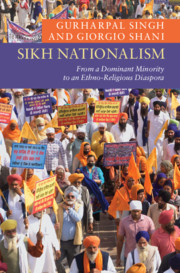Book contents
- Sikh Nationalism
- New Approaches to Asian History
- Sikh Nationalism
- Copyright page
- Contents
- Maps
- Figures
- Tables
- Acknowledgements
- Abbreviations
- Glossary
- Introduction
- 1 Understanding Sikh Nationalism
- 2 Sikhism and the Sikhs up to the 1890s
- 3 The Emergence of Modern Sikh Nationalism, 1880s–1930s
- 4 The Partition of India and the Sikhs, 1940–1947
- 5 The Indian Union and the Sikhs, 1947–1984
- 6 Militancy, Antiterrorism and the Khalistan Movement, 1984–1997
- 7 Sikh Nationalism in the Age of Globalisation and Hindutva, 1997 to the Present
- 8 The Diaspora
- Conclusion
- Timeline
- Appendix: Anandpur Sahib Resolution
- References
- Index
- New Approaches to Asian History
8 - The Diaspora
Published online by Cambridge University Press: 19 November 2021
- Sikh Nationalism
- New Approaches to Asian History
- Sikh Nationalism
- Copyright page
- Contents
- Maps
- Figures
- Tables
- Acknowledgements
- Abbreviations
- Glossary
- Introduction
- 1 Understanding Sikh Nationalism
- 2 Sikhism and the Sikhs up to the 1890s
- 3 The Emergence of Modern Sikh Nationalism, 1880s–1930s
- 4 The Partition of India and the Sikhs, 1940–1947
- 5 The Indian Union and the Sikhs, 1947–1984
- 6 Militancy, Antiterrorism and the Khalistan Movement, 1984–1997
- 7 Sikh Nationalism in the Age of Globalisation and Hindutva, 1997 to the Present
- 8 The Diaspora
- Conclusion
- Timeline
- Appendix: Anandpur Sahib Resolution
- References
- Index
- New Approaches to Asian History
Summary
In this chapter we provide a brief overview of the size and distribution of overseas Sikh communities. This is followed by a review of early forms of mobilisation by Sikh overseas communities before 1984. We then examine the main organisations that led the campaign for Khalistan during the turbulent decades of the 1980s and 1990s, focusing on their strategy and tactics and broader engagement with the community. With the decline of militancy in the Punjab in the 1990s and 9/11, new organisations emerged to actively engage with the ‘politics of recognition’ in the host states. We examine in detail the US-based Sikh Coalition and the UK-based Sikh Federation as organisations that are redefining the politics of the diaspora. The chapter concludes with reflections on the changing role of the diaspora in defining Sikh nationalism. As a small, self-conscious diaspora, the Sikhs are always prone to a critical event like 1984, a periodic tsunami that regularly restructures its politics and social life. The Sikh diaspora has the potential to lead the emergence of a global panth. It is also, however, a weather vane that continues to reflect the turbulent winds from South Asia.
Keywords
- Type
- Chapter
- Information
- Sikh Nationalism , pp. 189 - 210Publisher: Cambridge University PressPrint publication year: 2021

